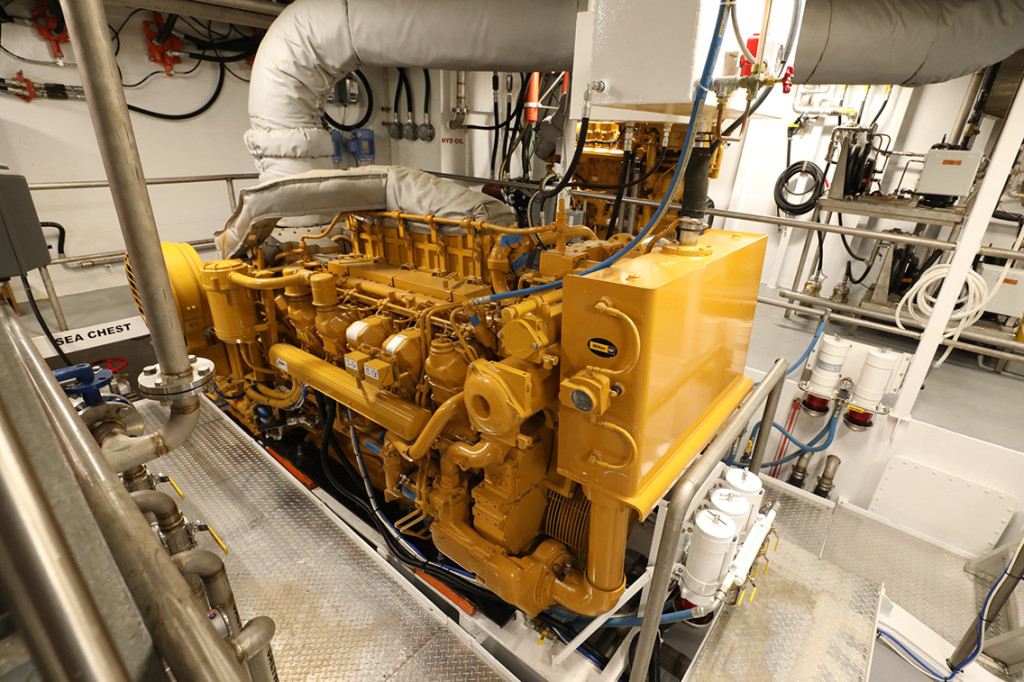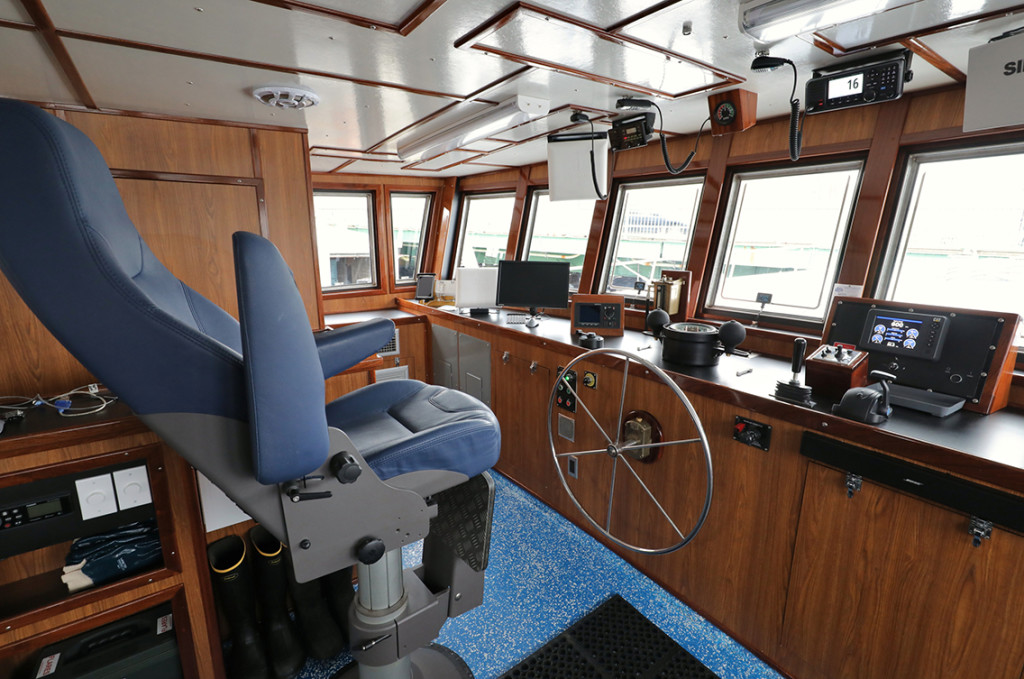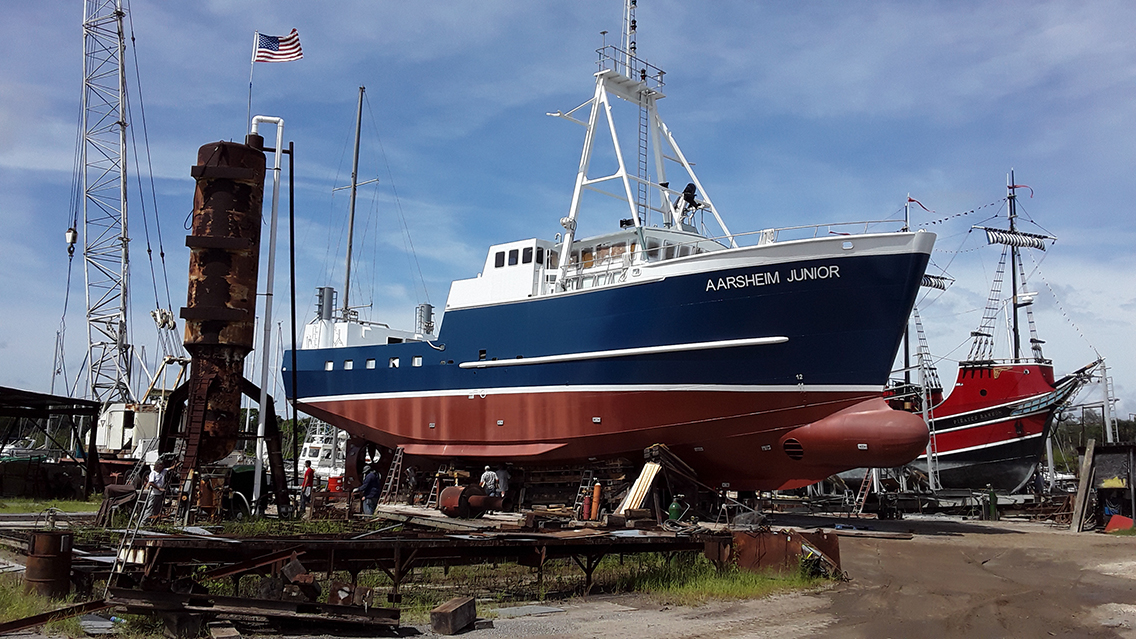The way Knute Aarsheim tells it, the story of his newest boat, the Aarsheim Junior, started with an engine, a beautiful 1,350-horsepower Tier III 3512 Cat. “I bought it 15 days before the law went into effect,” says Aarsheim, referring to emissions regulations that now require engines over 800-hp to be Tier IV.
“I’ve known Kevin Hampson at Caterpillar for a long time,” says Aarsheim. “He called me up and said, ‘The next time you buy an engine it’s going to cost you $750,000. But I so happen to have an engine right here, and I have a deal for you, but you have to act quickly.’ They called me because I’m a real schmuck. I discovered years ago that I’m hopeless, not useless, just hopeless. So I said, OK. I bought it. So then I had the engine; I had to build a boat.”
Aarsheim got a bargain on a $760,000 engine and then called Junior Duckworth, a longtime boatbuilder in Tarpon Springs, Fla. “Junior and I are on the same wavelength,” says Aarsheim.
Duckworth Steel Boats had built a boat for Aarsheim in 2018, the 104-foot Selje, and the Aarsheim Junior is an exact copy of the Selje, designed by John W. Gilbert Associates in Hingham, Mass.
“Gilbert designed my first boat,” says Aarsheim, referring to the Act I. Harvey Gamage built the Gilbert-designed boat on spec and sold it to Aarsheim in 1973. “It was one of the last boats he built,” says Aarsheim. “He died the next year.”

Aarsheim has had a number of boats but has now trimmed his fleet down to two, the Selje, and the Aarsheim Junior, which he owns in partnership with his son. “Two boats is perfect,” says Aarsheim. “So you can keep good people.”
Because of the limited number of fishing days available for one boat, the captain and crew of the Selje will take over the operation of the Aarsheim Junior, as well, giving them all enough fishing days to stay busy.
Like Aarsheim, Junior Duckworth at Duckworth Steel Boats has a long history with the fishing industry. His yard has built a number of boats for some of the best-known names in New England fishing, such as Frank O’Hara, Roy Enoksen, and of course Knute Aarsheim.
“She’s a pretty typical scalloper,” Duckworth says of the Aarsheim Junior. The 104-foot vessel, like its predecessor the Selje, has a 28-foot beam and draws 14 feet loaded. “She’s 8/36 steel plate,” says Duckworth. “It’s all ABS, they put a stamp on it. It’s all American steel now, there’s no more foreign steel.”
Duckworth starts with heavy transverse and longitudinal framing before shell plating the hull. While many boatbuilders use computers to create C&C files that enable them to precut all the plate, Duckworth does not.
“We do all the layout and cutting ourselves, the old-fashioned way,” he says. “I find I can save a lot of material that way.”
At Duckworth, a team led by men who have been with the company for as long as 25 years welds the plate from the inside. “Then we back gouge almost through to the inside weld so when we weld it makes a solid weld all the way through. It’s stronger,” says Duckworth.
Duckworth adds strength on the decking where the hefty 15-foot dredges will be landing repeatedly, sometimes with a bang in rough weather. “The plate there is 1 inch,” says Duckworth. “With 6-inch by 4-inch, 3/8-inch angle framing every 24 inches.”
Duckworth installed Aarsheim’s 3512 Cat with a German-made Reintjes 6:1 reduction gear turning a 7-inch Aquamet-17 shaft and an 84" x 78.755" four-blade propeller in a nozzle. For auxiliary power, the boat has a 65-kW John Deere genset.
“They have a 600-horsepower Cat C-18 to drive the hydraulics. It’s a 600-gallon system with a Sunstrand pump,” says Duckworth. “It’s actually two tanks, so if you lose fluid on one side you can open up the other and you don’t have to go back in. Marine Hydraulics did all the winches.”
According to Jerry Wheeler, general manager at Marine Hydraulics in New Bedford, they’re running four pumps off the Cat C18, and powering two Marine Hydraulics MH-195 winches, a pair of Pullmaster H-12 boom winches and smaller PO5s for the outriggers. “We sent the whole package to Duckworth,” Wheeler says. “We send schematics for the installation and provide tech support.”
According to Wheeler, the winch is bolted to heavy angle iron; workers run a line from the center of the winch to the towing block, and when it is perfectly aligned they tack weld the angle iron to the deck.
“Then they lift the winch off, bolt down the angle iron,” says Wheeler. Then the MH-195s — which can hold 350 fathoms of 11/8 cable and haul it at mean speed of 245 feet per minute — get bolted back to the angle iron. Wheeler notes that because they use Hagglunds motors, the winches can freewheel without any drag.
All the deck gear can be operated from an aft-facing control station in the wheelhouse. “We fabricate a drop-in control panel that they can just cut a hole for and install,” says Wheeler.
According to Duckworth, besides the hydraulics, the wheelhouse is packed with electronics. “A lot!” he says. “But don’t ask me what. Tony Vieira from T&K electronics did all that work.”

Vieira, also based in New Bedford, made three four-day trips to Tarpon Springs to install the electronics on the Aarsheim Junior. “I was down there for 12 days all,” says Vieira, the owner of T&K Marine Electronics. “He’s got two Furuno radars with remote displays. He’s got the TimeZero Nobeltec bottom builder and a PC windplot chart plotter.”
The extensive list of electronics Vieira installed also includes: two Furuno LH5000 loud hailers, a Furuno FA170 AIS, Furuno SC33 satellite compass, Furuno 220WX ultrasonic weather station, Furuno RD33 color remote display, two Furuno sounders (FCV295 and DFF-1 black box echosounder module for TZTouch), two Icom M605 25-watt VHFs with Shakespeare 476 antennas and Command mics, a Simrad AP70 MK2 autopilot with additional control head, S35 NFU (non-follow up) steering lever, FU80 steering lever (full follow up), Dirigo 6-inch magnetic compass, two Simrad NSS evo3 GPS units, two Fusion BT stereos w/SiriusXM, Nobeltec TZ Professional chartplotter w/PBG Module, a P-Sea Windplot II, and a Globalstar satellite phone.
“He’s got full controls in the back of the wheelhouse,” says Vieira. “And in his shucking house, he’s got the TZTouch, remote display, the TZ Nobeltec GPS and the Simrad FU80 to steer.”
On deck and in the shucking house, the crew has Fusion BT stereos with SiriusXM. Scallops are cleaned and bagged in the shucking house and sent down a chute into the hold.
“He’s got two holds,” says builder Junior Duckworth. “One is a regular hold where they just keep the scallops in with ice, the other is a freezer hold. But they’re not using the freezer yet.”
Duckworth estimates that the boat can hold around 100,000 pounds of scallops.
The crew limit for the Aarsheim Junior is seven people, Duckworth notes.
“But we built her with bunk space for 13 or 14,” he says. “That’s how many they used to take, and I guess they hope someday they can go back to that. There’s the captain’s stateroom with its own shower, a two-man stateroom, a four-man stateroom, and six-man stateroom. They all have their own showers, so they don’t have to wait around.”
Duckworth points out that there is also a head on deck. “That way they don’t have to come inside with all their gear,” he says.
Besides the high-end sound system for the crew’s entertainment, the boat has a KVH TV5 satellite TV in wheelhouse, galley and captain’s stateroom.
Aside from the suite of electronics, the Aarsheim Junior is, as Duckworth says, “a regular scallop boat,” but she carries decades of heritage. As Knute Aarsheim says, he and Duckworth are on the same wavelength, both men started in the 1970s and both are working with their children to continue their legacies, one as a Gulf Coast boat builder, the other as a New England fisherman. While Aarsheim partners to an extent with his son Keith, Duckworth’s two sons Joel and Jason and daughter Joy, keep much of the work going at Duckworth Steel Boats.
Within the context of the pandemic, neither operation has been hampered. “We just keep on going,” says Junior Duckworth.







